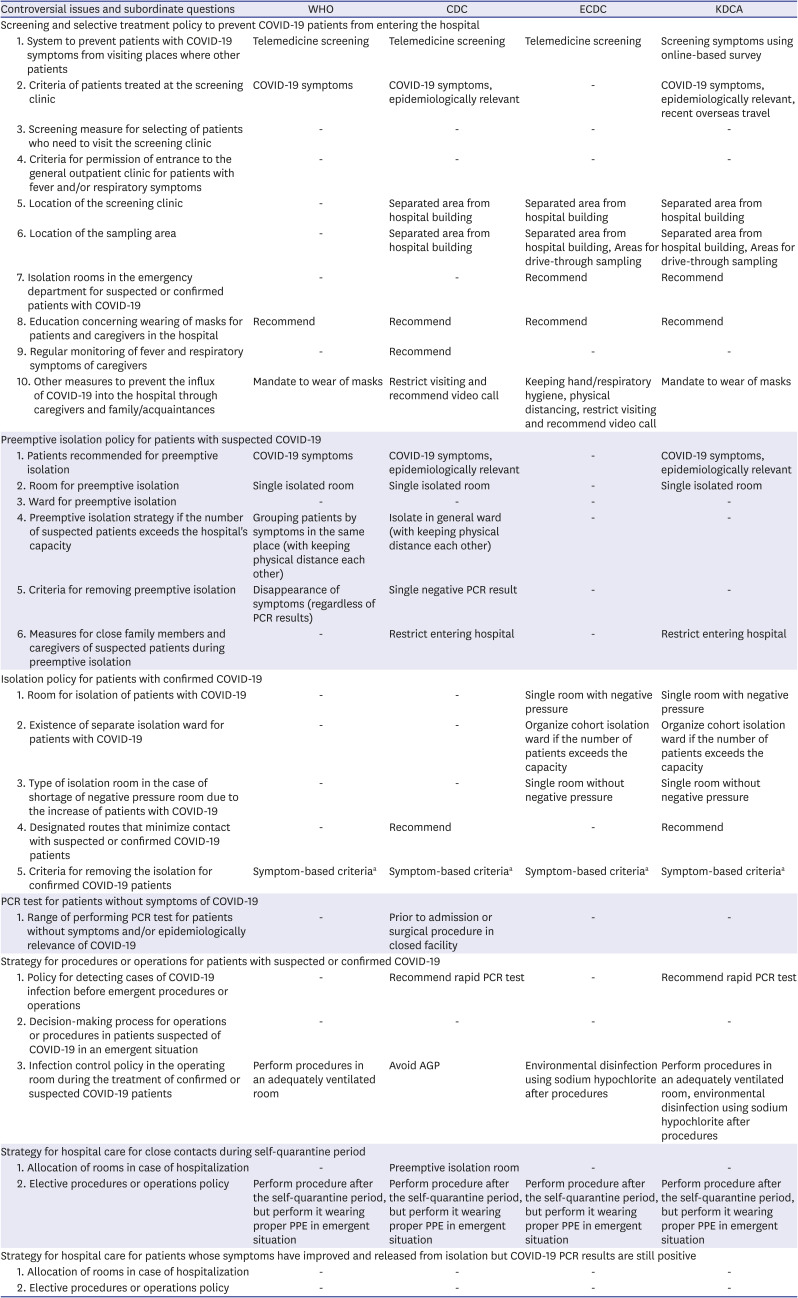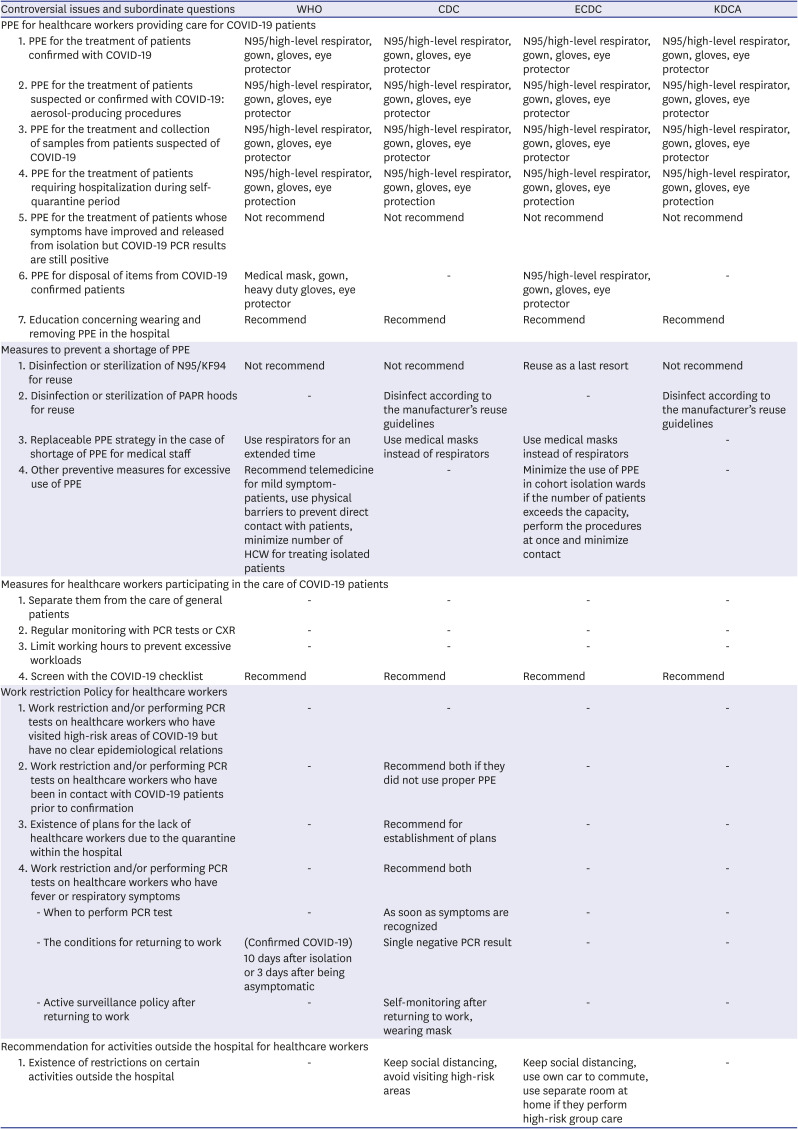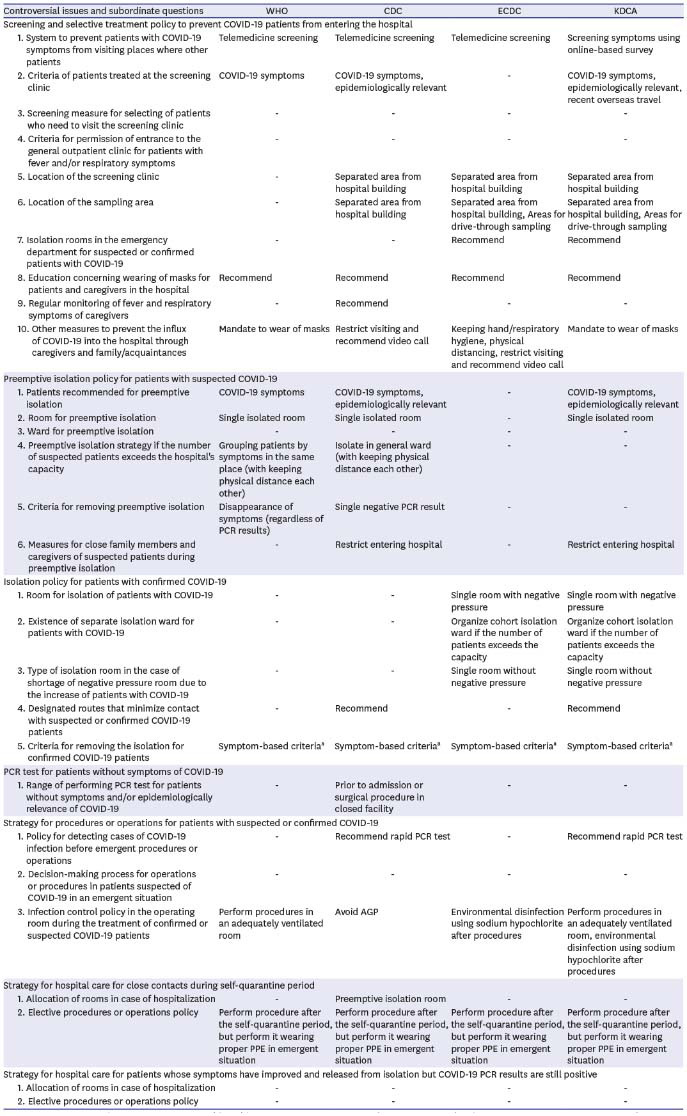2. World Health Organization (WHO). Rational use of personal protective equipment for coronavirus disease 2019 (COVID-19): interim guidance. Updated 2020. Accessed May 14, 2021.
https://apps.who.int/iris/handle/10665/331215
.
18. Kim JE, Lee JH, Lee H, Moon SJ, Nam EW. COVID-19 screening center models in South Korea. J Public Health Policy. 2021; 42(1):15–26. PMID:
33087849.

19. Shi HJ, Lee JB, Choi MK, Jang YR, Cho YK, Eom JS. Protection and response of a tertiary hospital in South Korea to the COVID-19 outbreak. Disaster Med Public Health Prep. 2021; 15(1):e1–e5.

20. Buitrago-Garcia D, Egli-Gany D, Counotte MJ, Hossmann S, Imeri H, Ipekci AM, et al. Occurrence and transmission potential of asymptomatic and presymptomatic SARS-CoV-2 infections: a living systematic review and meta-analysis. PLoS Med. 2020; 17(9):e1003346. PMID:
32960881.

21. Bai Y, Yao L, Wei T, Tian F, Jin DY, Chen L, et al. Presumed asymptomatic carrier transmission of COVID-19. JAMA. 2020; 323(14):1406–1407. PMID:
32083643.

22. Kim SE, Jeong HS, Yu Y, Shin SU, Kim S, Oh TH, et al. Viral kinetics of SARS-CoV-2 in asymptomatic carriers and presymptomatic patients. Int J Infect Dis. 2020; 95:441–443. PMID:
32376309.

24. Telford CT, Onwubiko U, Holland DP, Turner K, Prieto J, Smith S, et al. Preventing COVID-19 outbreaks in long-term care facilities through preemptive testing of residents and staff members - Fulton County, Georgia, March–May 2020. MMWR Morb Mortal Wkly Rep. 2020; 69(37):1296–1299. PMID:
32941413.

26. Cheng HY, Jian SW, Liu DP, Ng TC, Huang WT, Lin HH, et al. Contact tracing assessment of COVID-19 transmission dynamics in Taiwan and risk at different exposure periods before and after symptom onset. JAMA Intern Med. 2020; 180(9):1156–1163. PMID:
32356867.

27. Wölfel R, Corman VM, Guggemos W, Seilmaier M, Zange S, Müller MA, et al. Virological assessment of hospitalized patients with COVID-2019. Nature. 2020; 581(7809):465–469. PMID:
32235945.

28. Bullard J, Dust K, Funk D, Strong JE, Alexander D, Garnett L, et al. Predicting infectious severe acute respiratory syndrome coronavirus 2 from diagnostic samples. Clin Infect Dis. 2020; 71(10):2663–2666. PMID:
32442256.

29. Arons MM, Hatfield KM, Reddy SC, Kimball A, James A, Jacobs JR, et al. Presymptomatic SARS-CoV-2 infections and transmission in a skilled nursing facility. N Engl J Med. 2020; 382(22):2081–2090. PMID:
32329971.

30. Liu WD, Chang SY, Wang JT, Tsai MJ, Hung CC, Hsu CL, et al. Prolonged virus shedding even after seroconversion in a patient with COVID-19. J Infect. 2020; 81(2):318–356.

33. La Scola B, Le Bideau M, Andreani J, Hoang VT, Grimaldier C, Colson P, et al. Viral RNA load as determined by cell culture as a management tool for discharge of SARS-CoV-2 patients from infectious disease wards. Eur J Clin Microbiol Infect Dis. 2020; 39(6):1059–1061. PMID:
32342252.

34. Krupp K, Madhivanan P, Perez-Velez CM. Should qualitative RT-PCR be used to determine release from isolation of COVID-19 patients? J Infect. 2020; 81(3):452–482.

35. Lan FY, Wei CF, Hsu YT, Christiani DC, Kales SN. Work-related COVID-19 transmission in six Asian countries/areas: a follow-up study. PLoS One. 2020; 15(5):e0233588. PMID:
32428031.

36. Shreffler J, Petrey J, Huecker M. The impact of COVID-19 on healthcare worker wellness: a scoping review. West J Emerg Med. 2020; 21(5):1059–1066. PMID:
32970555.

37. Park SY, Kim B, Jung DS, Jung SI, Oh WS, Kim SW, et al. Psychological distress among infectious disease physicians during the response to the COVID-19 outbreak in the Republic of Korea. BMC Public Health. 2020; 20(1):1811. PMID:
33246426.

38. Xin H, Li Y, Wu P, Li Z, Lau EHY, Qin Y, et al. Estimating the latent period of coronavirus disease 2019 (COVID-19). Clin Infect Dis. Forthcoming. 2021; DOI:
10.1093/cid/ciab746.

39. Polack FP, Thomas SJ, Kitchin N, Absalon J, Gurtman A, Lockhart S, et al. Safety and efficacy of the BNT162b2 mRNA COVID-19 vaccine. N Engl J Med. 2020; 383(27):2603–2615. PMID:
33301246.

40. Thomas SJ, Moreira ED Jr, Kitchin N, Absalon J, Gurtman A, Lockhart S, et al. Safety and efficacy of the BNT162b2 mRNA COVID-19 vaccine through 6 months. N Engl J Med. 2021; 385(19):1761–1773. PMID:
34525277.







 PDF
PDF Citation
Citation Print
Print




 XML Download
XML Download